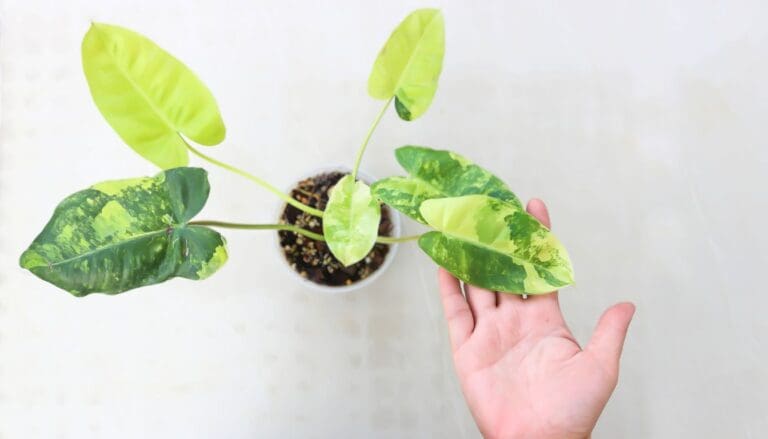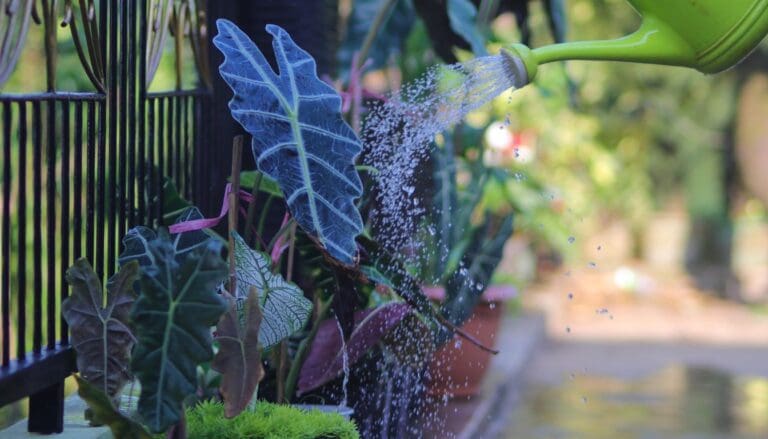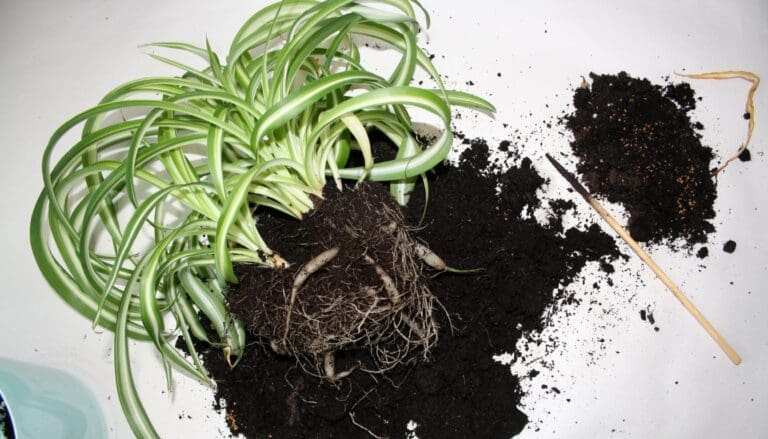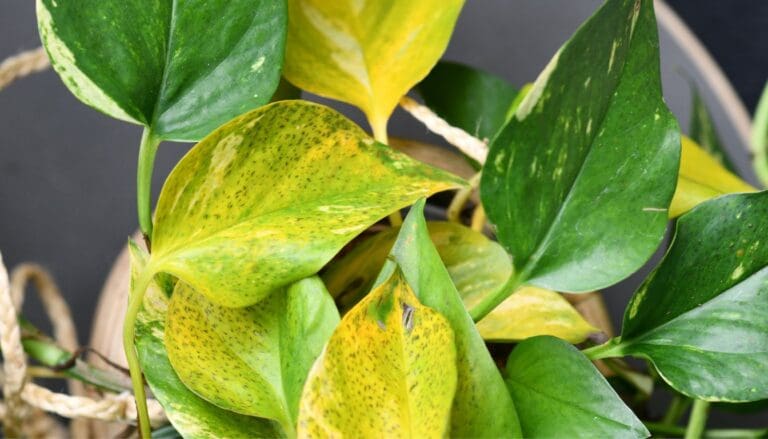How To Water Arrowhead Plant? (How Often+Summer & Winter)
Arrowhead plant or Syngonium is a popular houseplant with spade-shaped leaves. If you have one or want to get one, you must understand the water requirement and how to water your arrowhead plant.
Water your arrowhead plant when 50-75% of the topsoil feels dry. Bottom watering them is ideal, but if you can’t perform bottom watering, you can water the soil from the top. Water the arrowhead plant thoroughly until excess water starts draining out of the drainage holes.
In this article, Let’s discuss everything about watering an arrowhead plant or Syngonium.

Please note: Simplify Plants is reader-supported. Some links in the post are affiliate links and I get a commission from purchases made through links in the post.
Arrowhead Plant Water Requirements
The water requirement of the Arrowhead plant depends mainly on the season.
Many plants go through a dormant period during the winter season, and their water requirement changes during that time.
Let’s find out how seasons affect the water requirements of Arrowhead plants.
Summer
Like many houseplants, arrowhead plants grow actively during the summer and spring.
This is known as the growing period of the plant.
The plant receives bright light and more warmth during these seasons and requires more water.
Since the plant performs all its functions and grows actively during this time, it absorbs all the water you give it, so the soil dries up faster.
You must check the soil’s moisture every week and water your Syngonium whenever 50-75% of the soil feels dry.
In general, your arrowhead plant will require water once in 1-2 weeks, but it depends on other external factors such as the temperature, humidity, type of soil, etc.
Instead of following a fixed watering schedule, create a schedule only for checking the soil.
If the soil feels dry, provide water to the plant thoroughly.
Winter
Arrowhead plant or Syngonium prefers warm conditions and don’t react well to low temperatures.
Winter is not ideal for these plants as the days become shorter, the temperatures go down, the air becomes dry, and the intensity of the sunlight reduces.
Instead of focusing on growth, the plant goes into a dormant mode and tries to survive the adverse conditions by conserving its energy.
Since the plant slows down its growth during winter, it doesn’t absorb as much water as the growing seasons.
Also, the soil takes a lot longer to get dry due to the low light and low temperatures.
Therefore, you should reduce the watering to half, but the rule of thumb is to check the soil’s moisture level first and then water if it feels dry.
The arrowhead plant is also sensitive to cold water, so you should let the water come to room temperature before watering the plant.
Using cold water on the Syngonium can send it to shock, damaging the soil in various ways.
How do you know if the arrowhead plant needs water?

There are different ways to check and find out if your arrowhead plant needs water.
I will mention all, and you can use the ones that seem most convenient to you.
Moisture meter: Using a moisture meter is the most efficient way of checking the soil’s moisture, especially if you are a beginner.
Without getting your hands dirty, you can take the device and insert it into the soil.
If the reading shows 2 or 3, consider watering your arrowhead plant.
Use your finger: If you are comfortable getting your hands dirty, insert your finger up to a few inches into the soil.
If the soil feels dry, go ahead with watering your arrowhead plant and water it till the extra water starts running out of the bottom holes.
But if the soil sticks to the finger, wait for a few days and let the soil get dry.
Lift the pot: This process might require some practice before you learn to determine the soil’s moisture.
But when you lift the pot, and it feels heavy, it means that the soil still has moisture and the plant doesn’t require water.
But if the pot feels light upon lifting, it indicates that the soil is dry, and you can provide water to your arrowhead plant.
Touch the pot: If you are using a terracotta or clay pot for your arrowhead plant, you can touch the pot and tell if the plant needs water.
If the soil has enough moisture, the pot will feel wet when you touch it.
But if the plant needs water, the pot will feel dry along with the soil.
Observe the pot: Again, in the case of clay or terracotta pots, you can observe and tell if the soil is still moist and whether the plant needs water.
If the pot has a dark shade, the soil is still moist, but the soil is dry if the pot has a lighter shade.
Factors that determine the water requirement of Arrowhead plants
The water requirement of the arrowhead plant isn’t fixed as external factors such as light, temperature, humidity, etc., influence it.
Arrowhead plants require moisture, but they can’t tolerate soggy soil as they are susceptible to root rot.
This tells you that you must never overwater your arrowhead plant or Syngonium as the roots will easily get affected and start to rot.
The factors that determine the water requirement are:
- Light
- Temperature
- Humidity
- Pot
- Soil
Now let’s discuss these.
Light

Light is essential for the survival of plants. They use light to produce energy and food.
If your arrowhead plant gets a good amount of light, it will function efficiently and require more light.
Due to faster functioning, the plant will absorb more water and require water more frequently.
However, if your arrowhead plant is in a low-light area and doesn’t get enough light, it will function slowly and require less water.
Therefore, consider how much light your arrowhead plant is getting before watering it.
Also read: Arrowhead Plant Light Needs: What Type, How Much & More
Temperature
Arrowhead plants prefer high temperatures and don’t react well to low temperatures.
If it gets high temperatures, it will function better, and the soil doesn’t dry up faster.
This is one of the reasons why these plants require more water in the summer and spring seasons.
However, when the temperatures drop during winter, the plant fails to function optimally and goes into a dormant period.
Due to low functioning, the plant doesn’t use as much water when the temperatures remain low.
Humidity
Arrowhead plants come from high humidity regions and function well when the humidity is high.
But if the plant gets high humidity, it will not require a lot of water or very frequent watering.
If your Arrowhead plant doesn’t get enough humidity, you can mist it or use a humidifier to raise the humidity levels.
Pot

The pot material and size can play important roles in determining the water requirement of your Syngonium.
If you use terracotta or a clay pot, the plant will require more water as these materials are porous and wick away the moisture faster.
On the other hand, if you are using a plastic pot, the plant will require water less often as the soil will take time to dry in a plastic pot.
In the case of a big pot, the Syngonium will require less water as more soil will hold more water, taking longer to get dry.
Whereas less soil will hold less water in a small pot, taking less time to get dry.
So the plant will require frequent watering.
Soil
Arrowhead plants require well-drained soil as they are prone to root rot.
If your arrowhead plant is planted in well-drained soil, it will dry out faster, so the plant will need more water.
But if you use more dense soil, the water will take longer to dry out.
So, your arrowhead plant will require less water.
How often to water the arrowhead plant?
In general, arrowhead plants require water once in 1 to 2 weeks during the growing season.
You can decrease the watering to once in 2-3 weeks in the dormant season.
But keep in mind all the factors that I mentioned so you neither overwater nor underwater your arrowhead plant.
Never forget to check the soil and make sure it’s dry before watering the plant.
How to water the Arrowhead plant?
Arrowhead plants react very well to bottom watering.
Bottom watering is the method of the plant absorbing water from the bottom of its pot.
This is ideal for plants prone to root rot, as watering with this method reduces the chances of root rot.
This also reduces the chances of bacterial or fungal infection on the leaves due to water spillage.
- To perform bottom watering, you must first take a container and fill it with water. Remember to use room-temperature water.
- Now take the plant and put it on top of that container.
- Allow the pot to sit in the water for a few minutes.
- Check the soil. If it feels dry, leave the pot on the water for a few more minutes.
- Take the plant out and keep it in a well-lit spot.
When using the bottom watering method, consider watering from the top of the soil to allow the excess salt to leach out of the soil.
If you don’t do this, the excess salt from the fertilizer will remain in the soil and might burn the roots.
When watering the arrowhead plant from the top, you can poke the soil with a chopstick to create holes to aerate the soil and promote better water absorption.
What happens when you overwater your Arrowhead plant?

Arrowhead plants enjoy moist soil, but they can’t tolerate soggy soil.
Arrowhead plants are susceptible to root rot and easily rot when kept in soggy soil.
Therefore, I recommend checking the soil’s moisture every time before you water the plant.
However, it isn’t unusual to find someone overwatering their arrowhead plant, especially a beginner.
If you have an overwatered arrowhead plant, you will notice these:
- Droopy leaves: You will notice droopy leaves when your arrowhead plant is underwatered, but you might also spot them in case of overwatering. The overwatering weakens the plant, due to which the leaves lose their structure and droop.
- Yellow leaves: Yellow leaves are an initial sign of overwatering.
- Brown leaves: When you keep overwatering your arrowhead plant for a long period, the leaves get discolored and eventually turn brown. This can also signify root rot.
- Root rot: Root rot is an advanced stage of overwatering. This is a fungal disease where the roots remain wet in soggy soil, and due to a reduced oxygen supply, they start rotting. If you don’t repot your plant on time, it can die due to root rot.
- Pest infestation: Many pests look for a moist environment, and once they find it in your plant, the plant becomes the victim of the pest infestation. Pests like mealybugs, scales, and aphids can infect your arrowhead plant if you overwater it.
- Mold growth: Overwatering makes the soil soggy, a perfect environment for mold growth. You need to scrape the soil or change it by repotting the plant in a fresh soil mix if you notice this.
- Weak plant: Overwatering hits the roots and doesn’t let them function. Due to this, all plant parts become weak and fail to function.
How to prevent overwatering your Arrowhead plant?
First of all, get this belief out of your head that plants remain happier with more water.
You should water your Arrowhead plant only when it needs.
Keep the following in mind to avoid overwatering your arrowhead plant.
- Don’t follow a watering routine without checking the soil.
- Always check to determine the soil is dry before watering the plant.
- Provide good lighting conditions, so the water doesn’t remain in the soil for too long.
- Use well-drained soil, which can get rid of the excess water fast.
- Use a pot with drainage holes.
- Use clay or terracotta pots that can wick away the moisture faster.
- Reduce the watering in winter.
What happens when you underwater your Arrowhead plant?

In general, arrowhead plants require moist soil, so if you keep it dry for too long by not giving water to the plant, you’ll notice some signs that the plant gives out.
- Brown leaves: When your arrowhead plant doesn’t get enough water, the leaves become dry and brown due to dehydration. Prune these leaves as they will not turn green again.
- Crispy leaves: The leaves lose their texture due to lack of water and become crispy.
- Wilting leaves: Without sufficient water, the leaves try to conserve whatever water is retained in them. They do this by wilting.
- Dry soil: A clear sign of underwatering is dry soil. Without water, the soil loses all it has and becomes dry and compact.
- Slow growth: Arrowhead plants prefer moist soil and can’t function when they don’t get enough water. So, it is not unusual to notice slow growth when you have an underwatered plant.
How to prevent underwatering your Arrowhead plant?
If you want to avoid underwatering your Arrowhead plant, follow these steps:
- Water your Arrowhead plant whenever 50-75% of the soil feels dry.
- Plan a schedule to remind you to water your arrowhead plant.
- Don’t use soil that doesn’t retain enough water.
- The arrowhead plant will require more water when the weather is warm.
Reference: CABI, Britannica, United States Department of Agriculture, Wikipedia, Children’s Health Queensland Hospital and Health Service, Missouri Botanical Garden.
Recommended Garden Supplies
| Product Image | Our Recommended Gardening Supplies | Check Offers! |
|---|---|---|
Top Top
Top
Top
Top
Top
Top
Top
Top | rePotme Houseplant and Tropical Classic Potting Soil Mix | Check Offer On Amazon |
 Top
Top
Top
Top
Top
Top
Top
Top | Espoma Organic Indoor Plant Food | Check Offer On Amazon |
 Top
Top
Top
Top
Top
Top
Top
Top | GooingTop LED Grow Light 6000K Full Spectrum Clip Plant Growing Lamp | Check Offer On Amazon |
 Top
Top
Top
Top
Top
Top
Top
Top | Soil Moisture Meter | Check Offer On Amazon |
 Top
Top
Top
Top
Top
Top
Top
Top | Govee Hygrometer Thermometer, Bluetooth Enabled! | Check Offer On Amazon |
 Top
Top | LEVOIT Humidifiers for Large Room(Best For Plants) | Check Offer On Amazon |
 Top
Top
Top
Top
Top
Top
Top
Top | Upgraded DIY Automatic Drip Irrigation Kit, 15 Potted Houseplants Support | Check Offer On Amazon |
 Top
Top
Top
Top
Top
Top
Top
Top | Stainless Steel Heavy Duty Gardening Tool Set | Check Offer On Amazon |
 Top
Top
Top
Top
Top
Top
Top
Top | Bonide Insecticidal Soap | Check Offer On Amazon |
 Top
Top
Top
Top
Top
Top
Top
Top | Bonide 32 oz Spray Neem Oil for Organic Gardening | Check Offer On Amazon |
 Top
Top
Top
Top
Top
Top
Top
Top | Garden Safe Fungicide | Check Offer On Amazon |






